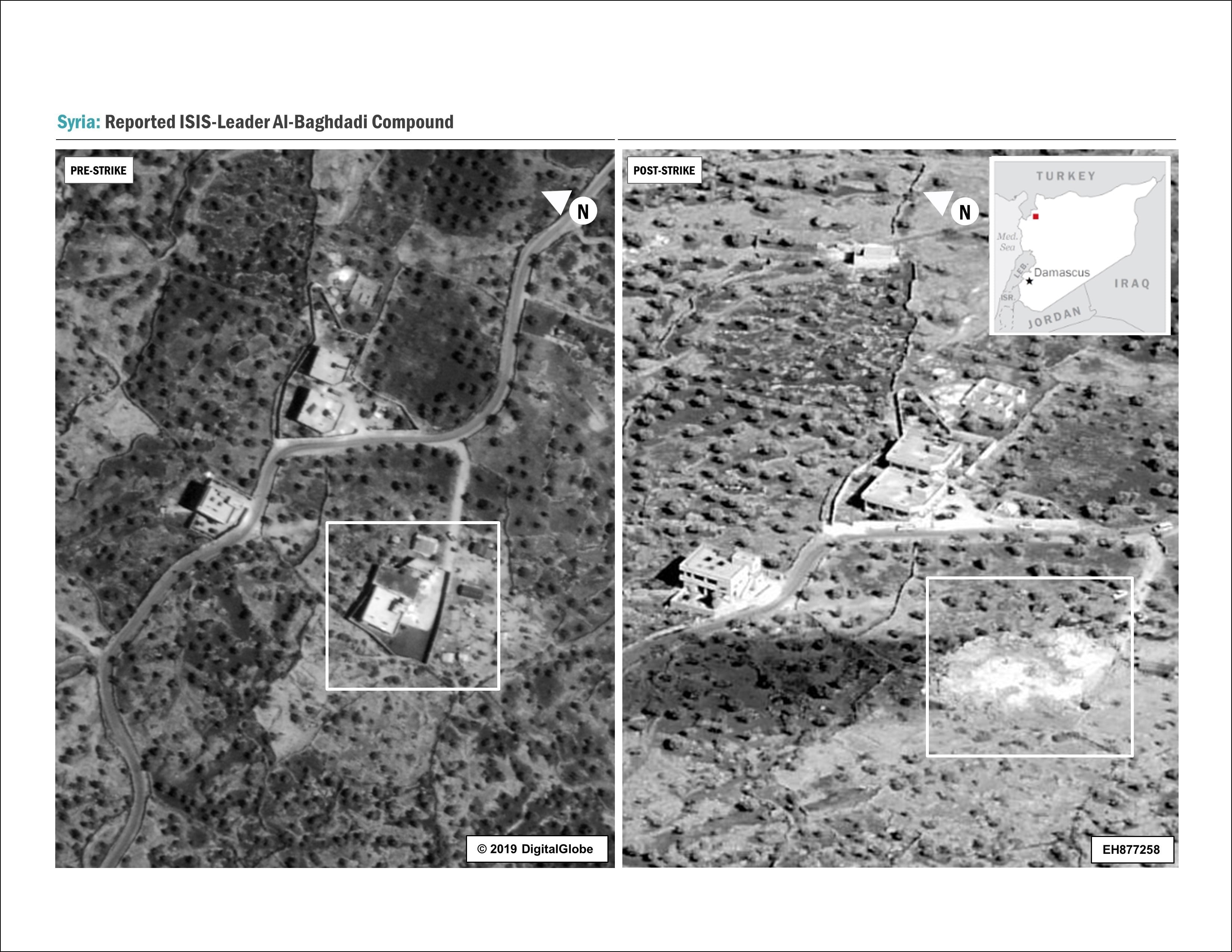Besides the raid that bagged Abū Bakr al-Baghdadi in late October, coalition forces have not conducted any strikes against ISIS targets in Syria since Turkey launched military operations in the country on Oct. 9, according to the U.S.-led anti-ISIS coalition.
While coalition aircraft are not physically striking ISIS remnants in Syria, officials with Operation Inherent Resolve said that anti-ISIS operations continue through intelligence collection and disrupting the terror network’s financing operations.
“We’re always collecting intelligence, disrupting Daesh media and finance, and preparing other missions,” OIR said in an emailed statement to Military Times. “Our eyes are always on ISIS remnants. The volume of strikes in Syria now reflects a more precise campaign to find and contain ISIS remnants.”
Turkish President Recep Tayyip Erdoğan announced the start of military operations to combat U.S.-backed Kurdish fighters in northern Syria. Turkey has long voiced that the Kurdish fighters are a terrorist organization.
U.S. officials and national security experts have warned Turkey’s incursion could jeopardize gains made by U.S. supported Syrian Democratic Forces, and breathe new life into ISIS.
But while the U.S. has not conducted any airstrikes against ISIS targets in Syria since Turkey launched military operations, strikes in the country had already waned considerably since the liberation of populous urban centers under ISIS’ control.
U.S. aircraft did strike unknown targets that displayed hostile intent towards the American commandos raiding Baghdadi’s compound in late October. Standoff munitions were also used to level the ISIS leader’s house following the operation.

But with the jihadi group mostly relegated to the desert and sparsely populated ungoverned spaces in Syria, ISIS targets of opportunity are rarer and harder to find.
According to the last emailed strike report from OIR, the U.S. conducted only two airstrikes against ISIS targets in Syria in August targeting six Daesh tactical units. Military Times has reached out to OIR for the date of the last strike in Syria, besides the raid that killed Baghdadi.
Bombs dropped in support of OIR have barley broke a 100 for each month since April. In August, coalition aircraft conducted released 218 munitions. There were 166 munitions released in October.
The coalition dropped 4,313 bombs in support of OIR in July 2017, when Mosul, Iraq was being liberated. About 1,642 munitions were released in October 2017, while Raqqa, Syria, as ISIS was being evicted by SDF forces from the city.
Data for the number of munitions released in support of OIR was provided by U.S. Air Forces Central Command’s monthly airpower summaries.
Following Turkey’s incursion into northern Syria, President Donald Trump ordered the withdrawal of U.S. forces from the region. Trump said he didn’t want American troops caught in the crossfire between combative allies.
The decision to withdraw drew much criticism from national security experts who warned the power vacuum created by U.S. forces would all ISIS to resurge in the region.
Trump has since slightly walked back that decision and had ordered a handful of troops to remain in Syria to keep oil wells from falling into the hands of ISIS fighters.
Some of the forces protecting the Syrian oil include American commandos and a mechanized force of Bradley fighting vehicles from the 30th Armored Brigade Combat team, a National Guard unit from South Carolina.
Delil Souleiman, a photographer with Agence France-Presse photographed Bradley vehicles moving near the Syrian town of Tel Tamir on Sunday.
The deployment of mechanized forces to Syria has raised a number of concerns regarding the manpower needed to sustain U.S. operations in the country. Prior to Trump’s decision to withdraw, the American footprint in Syria was roughly 1,000 troops.
Army Gen. Mark Milley, chairman of the Joint Chiefs of Staff, told ABC’s Martha Raddatz on Sunday that the about 500 to 600 U.S. troops would remain in Syria.
“There are still ISIS fighters in the region. And unless pressure is maintained, unless attention is maintained on that group, then there is a very real possibility that conditions could be set for a reemergence of ISIS,” Milley told Raddatz.
On Monday, Secretary of Defense Esper said the troop numbers mentioned by Milley were about right but he noted that the numbers change almost daily.
“That’s roughly the number, but we’re still wait for the commander’s going to come back and brief me sometime soon on the specifics that he’s seeking, and I’ll have the chance to look at that, and with general military — General Milley’s advice, either, you know, make modifications or simply affirm them,” Esper said.
“The Coalition continues to enable our Syrian Democratic Forces partners to deny Daesh resources and terrain in eastern Syria. Long term stabilization requires security, and ultimately our goal is to enable our partner forces in containing the Daesh threat to prevent a future resurgence,” OIR told Military Times in an emailed statement.
Shawn Snow is the senior reporter for Marine Corps Times and a Marine Corps veteran.




